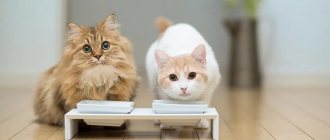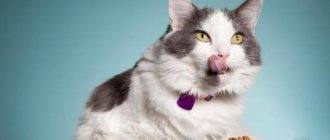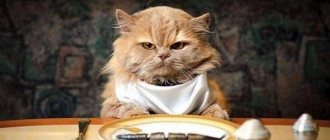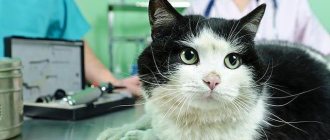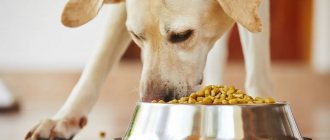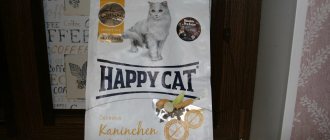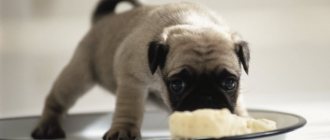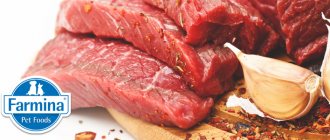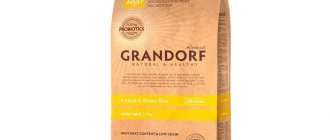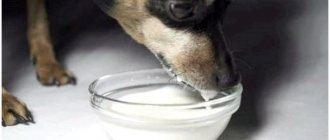Reasons for refusing dry food
Can't understand the reasons why a kitten refuses high-quality dry food? Let us immediately note that the situation must be considered in its entirety. Most often, kittens refuse to eat dry food because they do not perceive it as food. Accustoming to dry food should take place gradually, especially if the kitten has eaten only natural food from an early age.
A kitten may refuse dry food if it has missing molars or loose baby teeth. According to generally accepted rules, kittens are transferred to dry food in the form of granules no earlier than 7 months of age.
Age is not the first indicator when it comes to dental problems. If the kitten has ailments affecting the gums or oral cavity, the pet may refuse dry food because it experiences pain while chewing.
The second common reason why kittens refuse dry food is an unusual smell or taste. Feed is divided into: economy, premium, super-premium and holistic classes. Oddly enough, kittens eat economy food with pleasure, since they contain taste enhancers and seem very attractive to the animals.
The cat eats a lot and does not get enough: reasons
We must remember that cats can continue to grow for 3-5 years after birth. If your cat eats a lot and does not get enough, it may need more food to develop and maintain a normal level of functioning. It is worth finding out in more detail from specialized resources how many calories an animal of your breed usually eats per day, and how it changes depending on its age. Perhaps after some time your pet's appetite will stop at a certain point and stop growing.
The quality of the food also affects how much the cat eats. If an animal's diet is monotonous, it may no longer feel full when eating the same amounts of food. In addition, cheap cat food contains very few nutrients and vitamins, which is why animals experience a lack of the latter and try to make up for the norm by eating these products in large quantities.
Some owners overindulge their pets and overfeed them, until one day they begin to be surprised at the rapid decrease in the family budget. Unfortunately, during this time the cat’s stomach walls have expanded, and now it will be difficult for her to stop and reduce her diet.
There are also some features that are typical specifically for cats, and not cats: female cats often eat more than males, as they prepare their bodies for the possible onset of pregnancy. And some furry beauties abruptly stop eating during the period of heat due to increased nervousness, but after it they begin to eat food in endless quantities, replenishing lost calories.
Finally, the problem of a cat’s constantly high appetite may be the presence of worms and other parasites in the body. Also, eating food in large quantities is often a sign of various hidden diseases. You will no longer be able to figure out this situation on your own, and you will have to seek help from a veterinary clinic.
What to do if the kitten does not eat dry food
What to do if a kitten refuses to eat food from different brands? To begin with, take your time, perhaps the kitten needs to be accustomed to eating dry food, and the problem will be eliminated. If your pet looks sick or lethargic, or reacts poorly to food that is familiar to him, it is better to contact a veterinarian.
You can determine what exactly the kitten does not like is the food itself or its consistency. Instead of drying, you need to buy semi-moist or wet food of the same brand. If the kitten eats it, the problem is only in the unusual form of food (pellets).
Kitten rakes its paw next to a bowl
Many owners complain that the kitten tries to eat food, but quickly loses the initiative. At the same time, the pet paws next to the bowl, sniffs the granules, licks itself and meows questioningly, looking at the owner. What is the reason?
Most likely, the reason for your pet's insecurity is the pain he experiences when chewing or in a bowl that is too small. Pay attention to the length of your pet's whiskers.
The whiskers serve as an indicator by which the cat determines the width of the hole through which it can crawl. Instincts work here - if a cat's whiskers rest against the bowl, it automatically feels uncomfortable.
The second reason is weathering. Undoubtedly, dry food is stored longer, but under the influence of oxygen it oxidizes. Maybe you have noticed that the kitten only eats the top of the pile of food? If the answer is yes, the cause is food oxidation. Try to put in less food (exactly one serving), and always clean and wash the bowl.
Tricks and nuances of training to dry food
To help your pet eat dry food better, you can use small tricks:
- In the first month of training, we recommend lightly soaking the granules with low-fat meat broth. In this case, the gain is double: the kitten eats better, and its thin teeth are subjected to much less stress, which has a positive effect on the formation and health of the entire jaw system.
- There should always be a bowl of clean drinking water near the food bowl. The animal should be able to drink to its heart's content at any time! This, by the way, is important not only for kittens, but also for adult pets.
- You should choose food from the “Premium” or “Super-premium” category. Such diets contain a maximum of meat. This, firstly, improves the taste of food (the kitten eats better). Secondly, such a diet is much more beneficial for the baby’s growing body than if we compare it with Economy class food.
Is a cat eating that bad?
If your cat is healthy and the food is high-quality and fresh, monitor exactly how much she eats. Use precise measuring instruments for this: a kitchen scale or a measuring cup.
Sometimes the owner only thinks that the cat is not eating well, while she eats her quota and even overeats. The fact is that these animals prefer to eat fractionally: they approach the bowl up to 10–15 times a day, eating literally several granules in each approach. Therefore, if you poured a whole bowl of food, but the cat did not finish it, this is not surprising.
Check the feeding guidelines indicated on the product packaging. For example, a medium-sized cat needs only 40–60 grams of Acana Grasslands dry food per day. If your pet eats this amount of food (even in several meals), there is nothing to worry about.
The unusualness of new food
One explanation may be the animal’s banal unaccustomed to dry food. Life experiences shape eating habits and stereotypes, so if a cat has eaten exclusively natural food all its life, it may well not associate dry granules with food.
According to zoologists:
- Wild predators feed on the juicy flesh of their victims, and therefore cats instinctively absorb food with a high moisture content.
- Butchering whole prey whets the appetite, forcing you to separate portions and chew them thoroughly.
- The first feeding of small kittens should be especially rich in liquid to ensure optimal functioning of the delicate digestive system, which previously could only cope with milk.
Seductive wet food. If the animal looks good on homemade food and does not complain about appetite or health, then it would be more logical to leave the diet the same. But if the owner has firmly decided to feed the pet with industrial diets, then canned pates and pieces of meat in gravy can be offered as a transition link between natural food and dry food.
Typically, cats happily consume the contents of jars and bags, the ingredients of which, within the same brand, are not much different from dry food (except for the percentage of water). Perhaps, having tried wet food, the cat will deign to try dry granules.
Just for young animals and overly picky cats, manufacturers recommend mixed feeding, consisting of a portion of dry food and 1-2 bags of juicy food.
Taking into account the peculiarities of the recipe, it is advisable to choose granules and canned food of the same brand.
Gradual change of tastes. An option for “drying” training is to mix dry food granules with the usual food, which the cat eats with pleasure. It could be:
- chopped meat;
- sour cream;
- kefir;
- curdled milk;
- milk;
- bouillon.
After mixing, you need to wait a while for the granules to swell a little and become saturated with liquid.
Introduction of the first complementary foods. As the first complementary food for kittens aged 3-4 weeks, special dry food granules are soaked in warm boiled water until pureed (read more about how to properly soak dry food for kittens). If the baby refuses to eat, then you should gently open his mouth and smear a small amount of puree on the roof of his mouth. The procedure is repeated until the kittens begin to independently take food from their fingers, and then from the bowl. By 2 months, the amount of fluid is gradually reduced so that the growing baby learns to use his teeth and is not lazy to chew.
Selection of dry food. Sometimes cats have a strange taste and stubbornly refuse to eat the popular and beloved food or the one that is intended for them by age and breed. In such a situation, the owner has no choice but to offer the furry gourmet to choose by purchasing 5-10 types of dry food in small quantities at the pet store.
The main thing is not to forget to make a note about the corresponding brand and product name. Having sniffed the food offered in different bowls, the cat will still deign to eat this or that food, making it clear that he prefers fish, liver or an abundance of vegetables.
"Composition". Many owners ask the pet store seller to build a kind of “collection” of dry food of different flavors and brands in one bag, anticipating the pickiness of the pet. This is also done in order to save money, so that the granules of expensive food are mixed with cheap pieces.
Veterinarians do not advise constantly changing the manufacturer, or even more so feeding homemade mixtures of dry food, since the intestinal microflora adapts to the usual type of food.
Possible reactions to unfamiliar food may include vomiting, upset, or allergic reactions.
